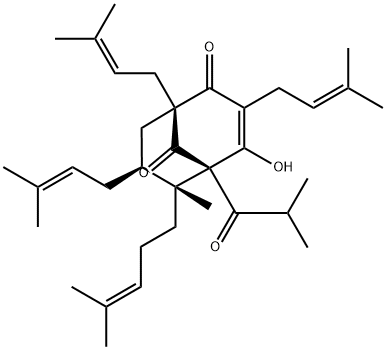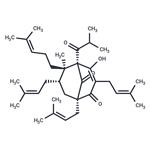Uses
St. John’s wort is a widely consumed herbal preparation which has been claimed to have a number of medicinal properties. It contains a number of known lipid signalling mediators, including chlorogenic acid, hypericin, hyperforin, and I3,II8-biapigenin. Hyperforin exhibits two activities which may alter the action of other concurrent medications. It inhibits the activity of several CYP450 enzymes, with CYP2D6 being the most sensitive with an IC50 of about 10 μg/ml. Hyperforin is also a ligand for the steroid X receptor (SXR). Since one activity of this receptor is the induction of CYP450 expression, the exact nature of hyperforin’s drug-drug interactions must be evaluated on a case-by-case basis. However, these interactions certainly complicate its use as a human therapeutic.[Cayman Chemical]
Uses
Hyperforin may be used:
- as a reference standard for calibration curve generation in high-perfornamce liquid chromatography (HPLC) analysis
- to test its cytotoxic effect and apoptosis induction in mouse embryonic cells
- as a pregnane X receptor (PXR) in porcine brain capillary endothelial cells for transport assay
Definition
ChEBI: A cyclic terpene ketone that is a prenylated carbobicyclic acylphloroglucinol derivative produced by St. John's Wort, Hypericum perforatum.
General Description
Hyperforin is a phloroglucinol component of St. John′s wort and a pregnane X receptor ligand.
Biochem/physiol Actions
Hyperforin is an active antidepressant and an inhibitor of cytochrome P450 3A4 (CYP3A). It elicits antioxidant and antibacterial activity. Hyperforin is also embryotoxic and inhibits tumor proliferation. It effectively inhibits dopamine, serotonin and norepinephrine.





